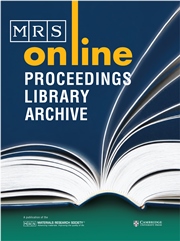Article contents
Enhanced Magnetic Transition of Core-Shell Cobalt-Platinum Nanoalloys
Published online by Cambridge University Press: 01 February 2011
Abstract
Synthesis of ‘solid solution’ and ‘core-shell’ types of well defined Co-Pt based nanoalloys smaller than 10nm have been achieved by redox transmetalation reactions. This redox transmetalation are selectively observed only if the redox potential between two metals is favorable. The composition of the magnetic alloys can also be tuned by adjusting the ratio of reactants. Annealed core-shell nanoparticles transformed into mixed nanoalloys with face centered tetragonal (fct) structures, which show large coercivity and ferromagnetism at room temperature. These nanoparticles can potentially be used as an independent single magnetic bit of tera-bit information storage. Also, this kind of redox transmetalation reaction can be utilized as a general process to synthesize various types of nanoalloys with controlled composition in a selective fashion.
- Type
- Research Article
- Information
- Copyright
- Copyright © Materials Research Society 2002
References
- 2
- Cited by


